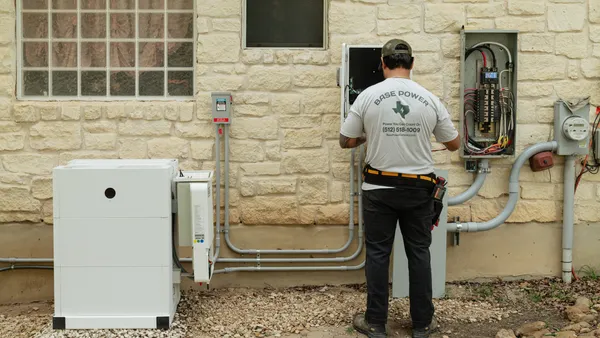In office parks and residential garages, thousands of power plants sit idle, just waiting to relieve building owners and utilities of high power prices when peak demand stresses the electric generation and distribution systems.
That’s the vision and promise, at least, as electric vehicles enter the mass market and the infrastructure to support them is built out. As thousands of electric vehicles are expected to hit the street over the next few years, their batteries, which could collectively store thousands of kilowatts of electricity, could be tapped at a moment's notice.
The idea has been discussed at trade events and in renewable energy circles for years: charge batteries overnight when wind energy is generally plentiful and cheap, and draw that power back onto the grid the next afternoon when demand is high. This burgeoning technology is called vehicle-to-grid, or V2G, and the technical barriers appear to be limited.
Now, major automakers are testing the idea.
Nissan's vehicle-to-building field test
Nissan, maker of the mass market Leaf, recently completed a preliminary field test of its vehicle-to-building system. The Nissan Advanced Technology Center in Atsugi City, Japan, has been conducting the test since July.
The system was simple. Nissan connected up to six Leafs to the building. When power was cheap, the cars recharged. When demand was high, the building drew power from the car batteries.
The building reduced demand by 25.6 kW during peak summer periods by controlling the charging time of the EVs, with no impact on the workers' daily commute. Power use was cut by 2.5% during peak hours -- or an estimated annual $4900 in savings for the customer. That's not insignificant and proves the concept has potential.
Honda's vehicle-to-grid pilot
Closer to home, Honda just joined a demonstration project for V2G technology with NRG Energy and the University of Delaware.
The university and NRG Energy already came online with a system in early 2013 showcasing how V2G technology could be used to sell energy storage from electric vehicles into the PJM Interconnection Regulation Market.
In the new project, Honda will provide an Accord plug-in hybrid to the University's Science, Technology and Advanced Research (STAR) Campus. The V2G system will monitor the status of the grid to determine whether the grid requires additional power sources that can respond rapidly, or if the grid requires power demands that can absorb transitional power supply.
"As the U.S. adds more intermittent resources to the grid, finding a lower cost energy storage technology that also benefits electric vehicle drivers is a great opportunity," said Denise Wilson, NRG Energy's EVP and president of new businesses.
Steven Center, VP of Environmental Business Development, agreed. "With V2G technology, a network of PEVs becomes essentially a distributed energy storage system," he said. "It makes for an even stronger value equation for plug-in vehicles, with benefits for both the community and the vehicle user."
Outlook for the future
Despite the sexiness of electric vehicles as demand-side management devices, electric vehicles have yet to penetrate a significant enough share of the market to make this much of a reality.
Research is ongoing on several fronts to test the feasibility of tapping into electric vehicles to balance load at peak hours. It is yet another idea being tested in the quest to meet peak demand, preserve grid reliability and avoid costly new power plants.
In particular, improvements in the cost and effectiveness of battery storage technology could bring new options to the demand management market in the years to come. SolarCity recently announced it is bundling distributed solar systems with Tesla batteries to store intermittently produced power. The key to SolarCity's play is an attempt to leverage energy storage to combat high demand charges, which is similar to the V2G idea.
So, in a future where dynamic pricing is more widely available, electric vehicles could empower consumers to charge their batteries on the cheap and avoid -- or at least minimize -- the punitive effect of peak power prices. But while electric vehicles may double as demand response devices, their long-term potential may be limited by the emergence of energy storage systems whose sole purpose is to act as a power source during hours of peak demand.
Only time will tell which technology—V2G or distributed storage—will hit the mass market first and help meet the power grid's need for responsive load flexibility.
Enjoyed what you read? You may also want to read Utility Dive's look at the 4 greatest challenges that utilities face in 2014.













